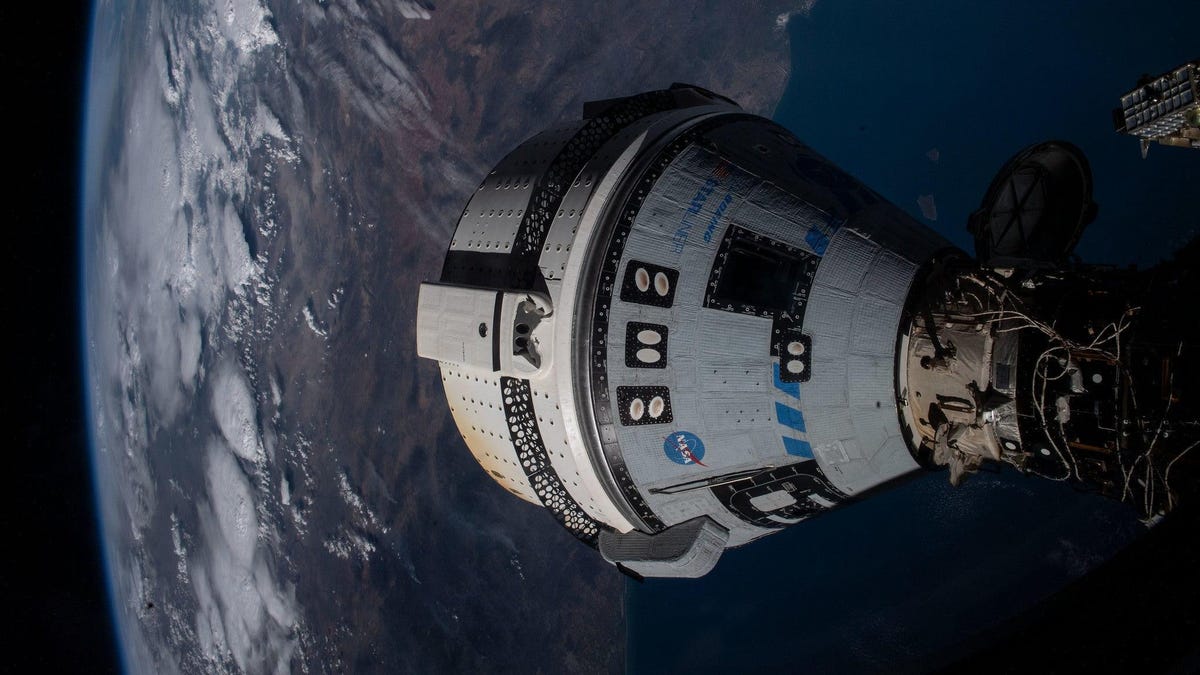
NASA astronauts Sunita Williams and Barry “Butch” Wilmore could finally hitch a ride to the ISS aboard Boeing’s CST-100 Starliner on July 21, but tests of the capsule’s parachute system threaten to delay the beleaguered project even further.
The first crewed mission of Starliner and its third flight overall has a launch date, but you’ll have to excuse my trepidation, given the project’s highly regrettable history. The $4.3 billion Starliner is years behind schedule, and we’ve already had to endure two schedule bumps this year alone; the Boeing Crew Flight Test (CFT) was slated to take off in February, but that got pushed to March, and then again to July 21, as NASA confirmed today during a press briefing.
Starliner is “largely ready for flight,” Steve Stich, manager of NASA’s Commercial Crew Program, told reporters. The main hang up, he said, is certification work that still requires completion, including some ground tests associated with the capsule’s parachute system. Traffic at the ISS is about to get busy, Stich added, citing yet another reason for the delay. Axiom Space’s planned private mission to the ISS, plus an upcoming cargo mission, meant that the “late July timeframe is the right time to fly Starliner,” he said.
Those parachute tests sound ominous—exactly the kind of thing that could further delay the CFT mission. Naturally, Stich did his best to downplay the tests, saying the team has “no issues or concerns” with the parachute systems and that it’s simply a matter of looking at the data to ensure safety. Mark Nappi, program manager for the Boeing Commercial Crew program, said he likewise feels confident about the parachutes and he doesn’t expect any surprises, he told reporters.
Assuming everything goes according to plan, ground teams will begin the fueling process some 40 days before launch. In terms of completed fixes, Nappi cited a logic error that emerged in a backup manual flight mode during ground simulations with the crew, which he said was simple to resolve with a slight modification to the vehicle. That said, the team now wants to make sure that this issue “doesn’t exist anywhere else and that it’s an isolated case.”
Starliner is one of two spacecraft included in NASA’s Commercial Crew Program, SpaceX’s Crew Dragon being the other. Dragon has been in operation for three years, while Starliner is still in the process of being certified. A steady stream of technical issues has prevented the Boeing project from taking off, but the uncrewed Orbital Flight Test 2 (OFT-2) test to the ISS went reasonably well, in what was an encouraging sign.
The CFT mission will last a minimum of eight days, both Stich and Nappi confirmed, but extensions are possible should the situation allow and if further tests are warranted. As for the existing ISS crew, Montalbano said the current plan is to return NASA astronaut Frank Rubio on a Russian Soyuz spacecraft on September 27. Should the plan stick, Rubio will have spent 371 consecutive days aboard the ISS, establishing a new record for a U.S. astronaut.
Rubio was originally supposed to return on the MS-22 Soyuz spacecraft, but the capsule’s radiator unexpectedly leaked out its coolant in December, rendering the vehicle unsafe for a crew. The uncrewed MS-22 returned to Earth yesterday, with unverified reports suggesting that internal temperatures rose to 122 degrees Fahrenheit (50 degrees Celsius) inside the cabin.
When asked about this during today’s briefing, Montalbano said he saw the report but that the technical team provided him with different information. He plans to converse with his Russian colleagues to better understand what happened so that NASA can make decisions about future crew returns. He promised to get back to reporters in about two to three weeks and possibly even hold a briefing on the topic that would include a “surgeon” to discuss potential health risks posed to astronauts when exposed to such extreme heat and humidity inside the capsule. Until his team speaks with Roscosmos, however, discussions about the conditions inside MS-22 remain speculation, Montalbano added.
Correction: A previous version of this article incorrectly stated that the logic error happened during Orbital Flight Test 2, when it in fact happened during ground simulations.
For more spaceflight in your life, follow us on Twitter and bookmark Gizmodo’s dedicated Spaceflight page.






